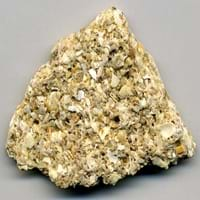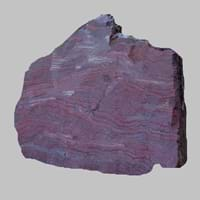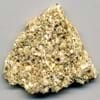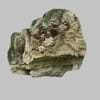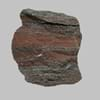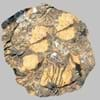Definition
Coquina is a sedimentary rock that is composed either wholly or almost entirely of the transported, abraded, and mechanically-sorted fragments of the shells of molluscs, trilobites, brachiopods, or other invertebrates
Banded iron formation are distinctive units of sedimentary rock that are almost always of Precambrian age
Origin
European Foreland Basins
Western Australia, Minnesota
Discoverer
Unknown
Unknown
Etymology
From Concha (Latin)+ Coquina(Spanish) +conch(English)= Couquina (mid 19th century)
From its formation process
Class
Sedimentary Rocks
Sedimentary Rocks
Sub-Class
Durable Rock, Soft Rock
Durable Rock, Medium Hardness Rock
Group
Not Applicable
Not Applicable
Other Categories
Coarse Grained Rock, Opaque Rock
Coarse Grained Rock, Opaque Rock
Texture
Clastic
Banded, Trellis
Color
Beige, Buff, Orange
Red, Reddish Brown
Durability
Non-Durable
Durable
Appearance
Layered, Banded, Veined and Shiny
Layered, Banded, Veined and Shiny
Interior Uses
Decorative Aggregates, Homes, Hotels, Interior Decoration
Decorative Aggregates, Homes
Exterior Uses
Garden Decoration, Office Buildings
Paving Stone, Office Buildings
Other Architectural Uses
Curbing
Curbing, Whetstones
Construction Industry
Building houses or walls, Construction Aggregate
As Dimension Stone, Used for flooring, stair treads, borders and window sills.
Medical Industry
Not Yet Used
Not Yet Used
Antiquity Uses
Artifacts, Monuments, Sculpture, Small Figurines
Artifacts
Commercial Uses
Creating Artwork
As a touchstone, Cemetery Markers, Creating Artwork
Types
Not Available
Algoma-type , Lake Superior-type, Superior-type and Taconite
Features
Available in Lots of Colors and Patterns, Is one of the oldest rock
Is one of the oldest rock
Archaeological Significance
Monuments
Used
Not Yet Used
Famous Monuments
Data Not Available
Not Applicable
Sculpture
Used
Not Yet Used
Famous Sculptures
Data Not Available
Not Applicable
Pictographs
Used
Not Used
Petroglyphs
Used
Not Used
Figurines
Used
Not Yet Used
Formation
Coquina is a sedimentary rock which is formed when billions of small clam-like seashell, called Coquina, or cockleshell are die and hence are deposited, buried and turns into a rock when pressure is applied.
The banded iron layers are formed in sea water when oxygen is released by photosynthetic cyano-bacteria. The oxygen then combines with dissolved iron in ocean to form insoluble iron oxides, which precipitated out, forming a thin layer of banded iron formation on ocean floor.
Mineral Content
Apatite, Augite, Bronzite, Calcite, Chert, Chlorite, Clay Minerals, Epidote, Feldspar, Garnet, Micas, Muscovite or Illite
Hematite, Magnetite, Quartz
Compound Content
CaO, Carbon Dioxide, Iron(III) Oxide, MgO
Fe, Iron(III) Oxide, Silicon Dioxide
Types of Metamorphism
Not Applicable
Not Applicable
Types of Weathering
Biological Weathering, Chemical Weathering, Mechanical Weathering
Chemical Weathering
Types of Erosion
Coastal Erosion, Sea Erosion, Water Erosion, Wind Erosion
Coastal Erosion, Wind Erosion
Grain Size
Coarse Grained
Large and Coarse Grained
Fracture
Irregular
Uneven, Splintery or Conchoidal
Porosity
Highly Porous
Highly Porous
Luster
Dull to Vitreous to Submetallic
Earthy
Cleavage
Not Available
Imperfect
Toughness
Not Available
1.5
Specific Gravity
1.10-2.24
5.0-5.3
Transparency
Opaque
Translucent to Opaque
Density
2.8-2.9 g/cm3
Not Available
Specific Heat Capacity
Not Available
Resistance
Heat Resistant, Impact Resistant, Pressure Resistant, Wear Resistant
Heat Resistant, Impact Resistant, Pressure Resistant, Wear Resistant
Deposits in Eastern Continents
Asia
Not Yet Found
China, India, Iran, Iraq, Oman, Russia, Saudi Arabia, Taiwan, Thailand, Vietnam
Africa
Not Yet Found
Kenya, Morocco, South Africa, Tanzania
Europe
United Kingdom
Austria, France, Greece, Italy, Malta, Poland, Portugal, Serbia, Spain, Sweden, United Kingdom
Others
Not Yet Found
Greenland, Mid-Atlantic Ridge
Deposits in Western Continents
North America
USA
Canada, Mexico, USA
South America
Not Yet Found
Bolivia, Brazil
Deposits in Oceania Continent
Australia
Not Yet Found
New South Wales, Queensland, South Australia, Western Australia
